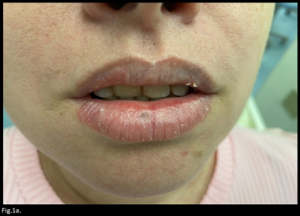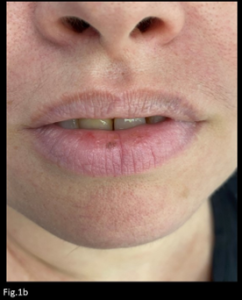Article / Case Report
Department of Stomatology, Division of Oral Medicine, School of Dentistry, University of São Paulo, Brazil.
Dante Migliari,
Departamento de Estomatologia,
Faculdade de Odontologia, Universidade de São Paulo
Av. Prof. Lineu Prestes, 2227, Cidade Universitária
São Paulo, SP – Brazil 05508-000
5 April 2024 ; 23 April 2024
Exfoliative cheilitis is a troublesome condition of lips which can be caused by different factors. One of them is a parafunctional habit of lip liking. This article describes such a case whose outcome was very successful as the patient was able to control her unrelented habit of moisturizing the lips with her tongue, along with a brief use of moderate potency topical corticosteroids.
Keywords: Exfoliative cheilitis, parafunctional habit, lip desquamation, clinical diagnosis
Intrinsic inflammatory diseases of the lip can be challenging for a proper diagnosis and management. There are several types of inflammatory cheilitis, which mainly include angular contact, exfoliative, actinic, glandular, granulomatous, etc. [1,2]. A thoughtful examination usually provides means to differentiate one form another, although not necessarily leading to a definitive diagnosis. A biopsy in not mandatory, except for cases in which the diagnosis may include lesions that exhibit histopathological features of dysplasia such as actinic cheilitis. Lip involvement in autoimmune disease, such as discoid lupus erythematosus, usually requires a biopsy.
This article describes a case of exfoliative cheilitis in which the diagnosis was made on a clinical basis exclusively as the patient had reported a recent habit of moisturizing the lips with the tongue.
A forty-two-year-old white female came to our clinic seeking treatment for her lip desquamation that had been presented for 3 months. Clinical examination revealed some erythematous patches on both lips along with several white adherent scales, predominantly on the lower lip (Fig.1a). Her main complaints were associated with burning sensation and aesthetic concern since the scales on the lips were a significant problem for her well-being. Medical history revealed that she had experienced some episodes of panic disorder and had been taking anxiolytic (clonazepam) to obtain some relief during the flare-ups. She was not a smoker nor alcohol consumer. Important notice that during examination she constantly tried d to moisturizes both lips by moving her tongue around them.
 Figure 1a: Multiple adherent white scales on both lips. There are also some erythematous patches on the lip vermillion and labial mucosa
Figure 1a: Multiple adherent white scales on both lips. There are also some erythematous patches on the lip vermillion and labial mucosa
Based on the clinical aspects of the lesion, together with the habit of moisturizing her lips with saliva aided by moving the tongue around them, a diagnosis of exfoliative cheilitis associated with lip liking was made. Management of the case involved advising the patient to refrain from this habit and to apply a topical corticosteroid of moderate potency in combination with gentamycin twice a day for two weeks. She returned four weeks after withdrew the medication. Her lips had improved substantially (Fig. 1b), and no recurrence has been observed so far, as she has also succeeded in avoiding her lip liking habit. To control lip dryness, she has been using a harmless lip balm.
 Figure 1b: a healthy aspect of the lips four weeks after withdrew from the use of corticosteroids as well as the lip liking habit. Her lower lip has a constitutional enlargement which exposes it to a constant dryness.
Figure 1b: a healthy aspect of the lips four weeks after withdrew from the use of corticosteroids as well as the lip liking habit. Her lower lip has a constitutional enlargement which exposes it to a constant dryness.
Inflammatory lip diseases require a detailed approach for establishing the diagnosis of the condition. In many opportunities, the diagnosis can be made on a clinical basis exclusively. Otherwise, a biopsy may be required [2-4]. But it should be borne in mind that a biopsy may not effectively solve some diagnosis difficulties. Inflammatory lip disease should be resolved preferably on a clinical basis since a biopsy is usually more a harmful to patients rather than a helpful procedure leading to therapeutic clues to the underlying condition [1,4].
In the present case, it was possible to unveil the cause of the lip desquamation and the burning sensation. The patient had a lip liking habit possibly related to her psychological condition of experiencing some episodes of panic disorder. Fortunately, she could manage her harmful habit with some help, at the beginning, by using a moderate potency corticosteroid. This was instrumental in boosting her self-steam as the medication was effective in eliminating the desquamation and the burning sensation. Afterwards, she could control her lip problem by herself. So far, she has succeeded very well in her endeavor.
- Almazrooa SA, Woo S-B, Mawardi H, Trieste N. Characterization and management of exfoliative cheilitis: a single-center experience. Oral Surg Oral Med Oral Pathol Oral Radiol. 2013 Dec;116(6):e485-9. DOI: 10.1016/j.oooo.2013.08.016.
- Lugović-Mihić L, Pilipović K, Crnarić I, Šitum M, Duvančić T. Differential Diagnosis of Cheilitis – How to Classify Cheilitis? Acta Clin Croat. 2018 Jun;57(2):342-351. DOI: 10.20471/acc.2018.57.02.16.
- Daley TD, Gupta AK. Exfoliative cheilitis. J Oral Pathol Med. 1995 Apr;24(4):177-9. DOI: 10.1111/j.1600-0714.1995.tb01161.x.
- Samimi M. Cheilitis: diagnosis and treatment. Presse Med. 2016;45:240-50. DOI: 10.1016/j.lpm.2015.09.024.













